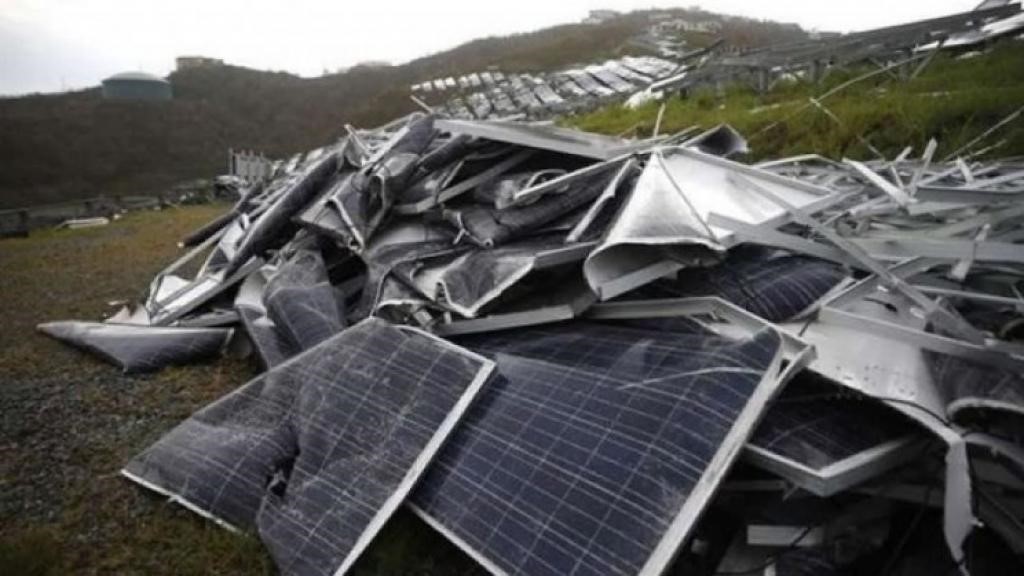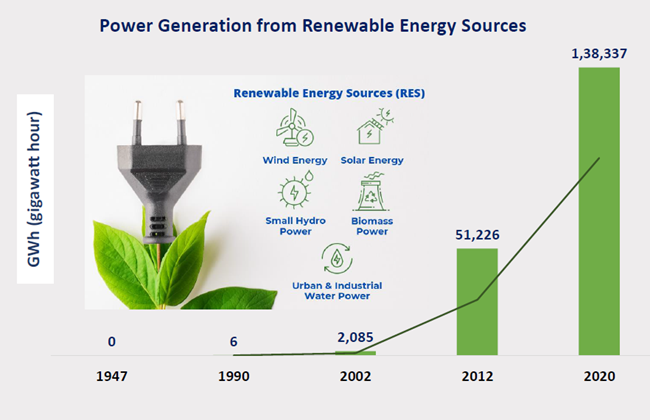Description

Disclaimer: Copyright infringement not intended.
Context
- There has in the last few years been a concerted push from policymakers in India to transition to a circular economy and to, among other things, enable effective waste management.
- But waste management in the solar photovoltaic (PV) sector still lacks clear directives.
Solar PV in India
Status of Solar PV in India
- Globally, India has the world’s fourth-highest solar PV deployment.
- The installed solar capacity was nearly 62GW in November 2022.
- India is expected to become one of the top five leading photovoltaic waste producers worldwide by 2050.
.jpeg)
Status of PV waste in India
- According to a 2016 report by the International Renewable Energy Agency, India could generate 50,000-3,25,000 tonnes of PV waste by 2030 and more than four million tonnes by 2050.
Solar PV Technology in India
- India’s solar PV installations are dominated by crystalline silicon (c-Si) technology.
- A typical PV panel is made of c-Si modules (93%) and cadmium telluride thin-film modules (7%).
- A c-Si module mainly consists of a glass sheet, an aluminium frame, an encapsulant, a backsheet, copper wires, and silicon wafers. Silver, tin, and lead are used to make c-Si modules.
- The thin-film module is made of glass, encapsulant, and compound semiconductors.
Recycling of PV waste in India
- Some portions of the frame are extracted and sold as scrap.
- Junctions and cables are recycled according to e-waste guidelines.
- The glass laminate is partly recycled; and the rest is disposed of as general waste.
- Silicon and silver can be extracted by burning the module in cement furnaces.
- According to a 2021 report, approximately 50% of the total materials can be recovered.
Challenges
- India’s challenge is the growing informal handling of PV waste.
- Only about 20% of the waste is recovered in general; the rest is treated informally.
- As a result, the waste often accumulates at landfills, which pollute the surroundings.
- Incinerating the encapsulant also releases sulphur dioxide, hydrogen fluoride, and hydrogen cyanide into the atmosphere.
- India needs to surmount significant collection, storage, recycling, and repurposing challenges.
- The market to repurpose or reuse recycled PV waste is minuscule in India due to a lack of suitable incentives and schemes in which businesses can invest.
Solutions
- India should formulate and implement provisions specific to PV waste treatment within the ambit of the e-waste guidelines.
- Central insurance or a regulatory body should be set up to protect against financial losses incurred in waste collection and treatment.
- Pan-India sensitisation drives and awareness programmes on PV waste management will be beneficial.
- Considering that India’s local solar PV-panel manufacturing is limited, we need to pay more attention to domestic R&D efforts.

Solar energy
About
- The term solar energy refers to the use of energy from the Sun.
- By installing solar panels and other systems, it can be used to obtain thermal energy or electricity generation.
- Solar energy received on Earth receives is ten thousand times greater than the one that is consumed per day.
- However, it is distributed in a more or less uniform way over the entire earth's surface, making it difficult to use.
Technologies to tap Solar Energy
Photovoltaic Solar Energy
- Photovoltaic solar energy is an energy technology used to produce electricity.
- Photovoltaic installations are made up of photovoltaic solar panels. These panels are made up of solar cells that have the virtue of generating an electric current thanks to the Sun.
- The current that comes out of a solar panel is direct current. The current converters allow us to transform it into alternating current.
- The electric current generated by the photovoltaic modules can be used to supply electricity in autonomous installations. It can also be used to supply it directly to the electricity grid.
Solar Thermal Energy
- Thermal solar energy can also be called solar thermal.
- This type of energy is another very habitual and economic use form. Its operation is based on the use of solar radiation to heat water through solar collectors.
- Solar collectors increase the temperature of the fluid by increasing its internal energy. In this way, it is easy to transport the generated thermal energy and use it where it is needed. A common use of this type of energy is to obtain domestic hot water or for heating in a residential solar.
- Concentrating Solar Power: There are large-scale solar thermal power plants that use this technique to subject water to high temperatures. Afterward, it is converted into steam. This steam is used to power steam turbines and generate electricity.
Passive Solar Energy
- Passive systems take advantage of solar radiation without the use of any intermediate device or apparatus.
- This technique is done through the proper location, design, and orientation of the buildings. It does not need panel installation.
- Passive solar energy is the oldest method of harnessing solar radiation. It is the method that ancient cultures already used as explained in the history of solar energy.

Solar Energy in India
The Numbers
- India has surpassed 50 GW of cumulative installed solar capacity, as on 28 February 2022. This is a milestone in India’s journey towards generating 500 GW from renewable energy by 2030, of which 300 GW is expected to come from solar power.
- India’s capacity additions rank the country fifth in solar power deployment, contributing nearly 6.5% to the global cumulative capacity of 709.68 GW.
- The top States in terms of installed solar energy capacity (March 2021) include: Karnataka (7.35 GW), Rajasthan (5.73 GW), Tamil Nadu (4.47 GW), Gujarat (4.43 GW) and Andhra Pradesh (4.2 GW).
Concerns
- Of the 50 GW installed solar capacity, an overwhelming 42 GW comes from ground-mounted solar photovoltaic (PV) systems, and only 6.48 GW comes from roof top solar (RTS); and 1.48 GW from off-grid solar PV.
- The large-scale solar PV focus fails to exploit the many benefits of decentralised renewable energy (DRE) options, including reduction in transmission and distribution (T&D) losses.
- There is limited financing for residential consumers and Small and Medium Enterprises (SMEs) who want to install RTS.
- Coupled with lukewarm responses from electricity distribution companies (DISCOMS) to supporting net metering, RTS continues to see low uptake across the country.
- The utility-scale solar PV sector continues to face challenges like land costs, high T&D losses and other inefficiencies, and grid integration challenges.
- There have also been conflicts with local communities and biodiversity protection norms.
- Also, while India has achieved record low tariffs for solar power generation in the utility-scale segment, this has not translated into cheaper power for end-consumers.
- India’s Domestic Content Requirement (DCR) clause has faced legal challenges at the World Trade Organisation (WTO).
- Backward integration in the solar value chain is absent as India has no capacity for manufacturing solar wafers and polysilicon.
- In 2021-22, India imported nearly $76.62 billion worth solar cells and modules from China alone, accounting for 78.6% of India’s total imports that year. Low manufacturing capacities, coupled with cheaper imports from China have rendered Indian products uncompetitive in the domestic market.
Solutions
- Governments, utilities, and banks will need to explore innovative financial mechanisms that bring down the cost of loans and reduce the risk of investment for lenders.
- Increased awareness, and affordable finance for RTS projects could potentially ensure the spread of RTS across the scores of SMEs and homes around the country.
- Aggregating roof spaces could also help reduce overall costs of RTS installations and enable developing economies of scale.
- India needs to embrace a circular economy model for solar systems. This would allow solar PV waste to be recycled and reused in the solar PV supply chain.
Initiatives
- Government of India have launched various schemes to encourage generation of solar power in the country like Solar Park Scheme, VGF Schemes, CPSU Scheme, Defence Scheme, Canal bank & Canal top Scheme, Bundling Scheme, Grid Connected Solar Rooftop Scheme
- Various policy measures undertaken included:
- Declaration of trajectory for Renewable Purchase Obligation (RPO) including Solar,
- Waiver of Inter State Transmission System (ISTS) charges and losses for inter-state sale of solar and wind power for projects to be commissioned up to March 2022,
- Guidelines for procurement of solar power though tariff based competitive bidding process,
- Standards for deployment of Solar Photovoltaic systems and devices,
- Provision of roof top solar and Guidelines for development of smart cities,
- Amendments in building bye-laws for mandatory provision of roof top solar for new construction or higher Floor Area Ratio,
- Infrastructure status for solar projects,
- Raising tax free solar bonds,
- Providing long tenor loans from multi-lateral agencies, etc.
- The MNRE launched the Jawaharlal Nehru National Solar Mission in 2010 to achieve 20 GW of grid connected solar power by 2022. The target was revised to 100 GW in 2014-15.

Grid connected
- The scheme for “Development of Solar Parks and Ultra-Mega Solar Power Projects” was rolled out in December, 2014 with an objective to facilitate the solar project developers to set up projects expeditiously.
- CPSU Scheme Phase-II (Government Producer): To set up solar PV projects through Government Producers using domestic cells & modules in WTO compliant manner to facilitate national energy security and environment sustainability for Government purpose.
- Solar Rooftop Programme: To achieve a cumulative installed capacity of 40,000 MW from Grid Connected Rooftop Solar (RTS) projects.
Solar Off-grid
- PM KUSUM: The scheme aims to add solar and other renewable capacity of 30,800 MW by 2022 with total central financial support of Rs. 34,422 Crore including service charges to the implementing agencies. The Scheme consists of three components:
- Component A: 10,000 MW of solar capacity through installation of small Solar Power Plants of individual plants of capacity upto 2 MW.
- Component B: Installation of 20 lakh standalone Solar Powered Agriculture Pumps.
- Component C: Solarisation of 15 Lakh Grid-connected Agriculture Pumps.
International Solar Alliance
- In addition to an impressive domestic track record, through the International Solar Alliance (ISA) established by India and France at COP-21 in 2015, there is a global platform to bring countries together to facilitate collaboration on issues such as mobilising investments, capacity building, program support and advocacy and analytics on solar energy.
- Technology sharing and finance could also become important aspects of ISA in the future, allowing a meaningful cooperation between countries in the solar energy sector.
Other steps
- Suryamitra Skill Development Programme by the National Institute of Solar Energy (NISE) focuses on Solar Energy project’s installation, operation & maintenance.
- Atal Jyoti Yojana has been launched to provide solar street lighting systems for public use.
- Under the Solar Transfiguration of India (SRISTI) Scheme, financial incentives are provided to the beneficiary for installing solar power plant rooftop projects.
- Green Energy Corridor Scheme: It is related to laying of new transmission lines and creating new sub-station capacity for evacuation (from region of production to region of consumption) of renewable power.
- The Government has also provided financial incentives for expansion of solar energy.
- India has proposed the idea of “One Sun, One World, One Grid” as a means of tapping into the copious solar electricity available on a worldwide scale.

Renewable Energy in India
|
Solar
|
Wind
|
Small hydro
|
Large hydro
|
Biopower
|
Nuclear
|
|
48.55 GW
|
40.03 GW
|
4.83 GW
|
46.51 GW
|
10.62 GW
|
6.78 GW
|

- At COP-21 in Paris in 2015, India committed to a 40% share of power generation from non-fossil fuel sources. We have achieved this target a decade ahead of the 2030 timeline.
- India has always shown its willingness in leadership to fight climate change. The country’s vision is to achieve Net Zero Emissions by 2070, in addition to attaining the short-term targetswhich include:
- Increasing renewables capacity to 500 GW by 2030,
- Meeting 50% of energy requirements from renewables,
- Reducing cumulative emissions by one billion tonnes by 2030, and
- Reducing emissions intensity of India’s gross domestic product (GDP) by 45% by 2030.
|
PRACTICE QUESTION
Q) There has in the last few years been a concerted push from policymakers in India to transition to a circular economy. But waste management in the solar photovoltaic (PV) sector still lacks clear directives. Critically Analyse this statement. (250 words)
|

https://epaper.thehindu.com/ccidist-ws/th/th_delhi/issues/30551/OPS/GLCB2420V.1+G3UB249F9.1.html













